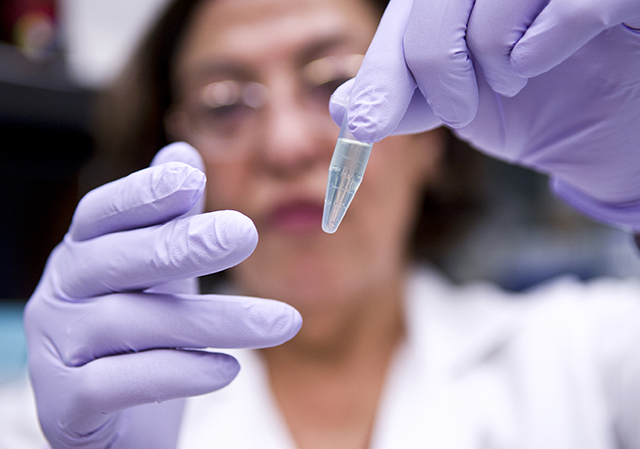Progress notes: unraveling the mysteries of salivary dysfunction

There’s a case study Dr. Ibtisam Al-Hashimi likes to share with dental students. In it, the patient’s chief complaints are all over the place: seasonal allergies, asthma-like symptoms, sore mouth, reflux, irritable bowels, and aches and pains. Everything in the lab work comes back perfect, but the patient is miserable. The symptoms are seemingly unrelated, but if you look closer, there’s one commonality. The answer lies in the exocrine system, which includes the salivary glands.
Patients often suffer a long time before coming to see Al-Hashimi, professor in periodontics and director of the college’s Salivary Dysfunction Clinic. The clinic — formed in 1991, just after Al-Hashimi’s arrival at Texas A&M University Baylor College of Dentistry — is uniquely positioned as a hub to treat patients with salivary dysfunction and by default, Sjögren’s syndrome, a little-understood but extremely prevalent autoimmune condition. Almost immediately, patients with Sjögren’s, which causes the body’s white blood cells to attack moisture-producing glands, flocked to the clinic for its diagnostic services.
Because TAMBCD has one of the only noncommercial labs in the country dedicated to patient salivary analysis as a diagnostic tool, the opportunities for interprofessional collaboration and research are plentiful. A recent collaboration with the University of Toledo and its hospital in Ohio resulted in the publication of a study examining the type of comorbidities associated with Sjögren’s syndrome and an article currently in press that examines a new diagnostic tool based on genetic markers. A contribution to the August issue of The Journal of the American Dental Association details management of dry mouth and underactive salivary glands.
Now Al-Hashimi talks a bit more about what enticed her to devote her career to the study of saliva, just how important it is to our well-being and how salivary gland problems are invariably a manifestation of exocrine dysfunction.
NewsStand: Your education traces back to the University of Baghdad, where you received your bachelor’s degree in dental surgery and diploma in oral surgery, and to State University of New York at Buffalo, where you received a master’s in oral sciences and a doctoral degree in oral biology. What was it that enticed you to study saliva?
Al-Hashimi: In Buffalo I ended up working in a lab that focused on salivary biochemistry. I came from a clinical background, and I wanted to see what happens when people have trouble with their saliva.
It really became a passion for me the more I got into this clinical practice and started seeing the issues that come along with it. I became more interested in understanding problems with salivary glands, and before I knew it, we started seeing a lot of patients with dryness that wasn’t limited to their mouths but also occurred in their eyes — a symptom of Sjögren’s. When I came here and started the salivary dysfunction clinic, before I knew it, it had become a referral center for Sjögren’s, which started as a consortium with UT Southwestern, Baylor University Medical Center and Texas Health Presbyterian Hospital Dallas and now includes several more physicians throughout the metroplex.
NewsStand: When you first joined the TAMBCD faculty in 1991, you re-energized the Dallas chapter of the Sjögren’s Syndrome Foundation Support Group. In that time period, what successes have you seen in terms of how people cope with the condition?
Al-Hashimi: When I came to Dallas, I reactivated the support group, and we started having meetings and symposia. The school still hosts the group’s quarterly meeting.
One really good resource for patients has been to talk with people who have exactly the same thing; not that everybody cries on everybody’s shoulder, but that they increase awareness and education. The benefit of the meetings is the educational programs where professionals come to educate the patients and make them knowledgeable of their condition and how to avoid potential complications. A lot of pulmonary and gastrointestinal problems come along with Sjögren’s syndrome. Not many people are aware of how easily you can prevent the complications that come with impaired exocrine dysfunction just by knowing what to do and how to take care of it.
NewsStand: In what ways can salivary dysfunction research and treatment stand to grow?
Al-Hashimi: My dream is that one day we will have a specialty in the exocrine system just like the endocrine system. Medicine is expanding so much, and there are specialists for an organ and a disease, but there is no specialist for the exocrine glands, which are distributed throughout the body, including the respiratory system, starting from the nose, sinuses, and through the lungs; and the entire digestive system, gallbladder, digestive enzymes, liver, pancreas, and the genitourinary tract. Problems and dysfunction within the exocrine system have a wide range of impact on those systems and the entire body, however, neither medical nor dental education addresses this system as one entity. Considering the abundance and accessibility of the salivary glands in the mouth, I believe dentists can play a significant role in better understanding the underlying causes of exocrine dysfunction.
NewsStand: There are some interesting nicknames attributed to you — Spit Doctor, Spit Lady, Dr. Spit — to name a few. Where did these offbeat monikers originate?
Al-Hashimi: I initiated it. Whichever one you want me to be, that’s me. I always award myself those titles. People think so little about saliva, but here we really know how valuable it is. Just ask a patient with dry mouth, and then one can appreciate the significance and systemic implications of salivary and exocrine dysfunction. It is not just saliva; it is the entire exocrine system.